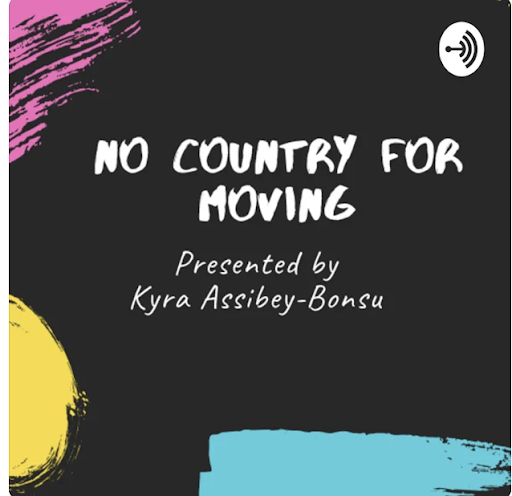Create Create Change Fellows Kyra Assibey-Bonsu and Madjeen Isaac are artists who share an interest in engaging with Black immigrant communities. For our Creative Conversations series, Kyra and Madjeen talked about their experience and approach to working with Black immigrant communities, and how their practices highlight the lives of those from these communities.
This interview has been lightly edited for clarity and brevity.
Who are we?
My name is Madjeen Isaac, I am Haitian American, born and raised in Brooklyn NY.
My name is Kyra Assibey-Bonsu. I’m a Ghanaian first and an accidental Texan second. Both are inescapable truths.
What is your practice and what do we specialize in?
Madjeen: I am a visual artist specializing in oil painting. I also personally dabble in collage and photography and have been called to expand and explore other mediums!
My current bodies of work are a tender offering to utopian urban living, rooted in hybridizing my ancestral homeland Haiti with my hometown Brooklyn. I enjoy depicting Black and Brown folks engaging in abundance, joy, liberation, leisure, and communality without the constraints of reality.
Kyra: My focus is on the elevation of marginalized communities through audio as well as by providing platforms and spaces for these voices. I intend on weaving community stories that highlight Black history. I’m a brand new audio nerd with a passion for the gift of gab, I love to chat with others about who they are, how they came to be, and where they are going.

How did we arrive to do what we do?
Madjeen: During my 3rd year at undergrad, I was given an assignment to explore the theme “culture”. Though very broad, I made it an opportunity to explore my Haitian American culture, identity, and upbringing in Brooklyn.
That following summer I also traveled to Haiti, spent time with family, and truly observed the landscape which ignited inspiration and provided me a newfound understanding of my lineage, Haitian history, and immigrants back home in Flatbush Brooklyn. I was taken aback at the similarities and ways of being folks and Haiti and in Brooklyn. They created a community-driven ecosystem and contributed to society through family-owned markets, restaurants, and transportation businesses.
Reimagining spaces and painting utopia landscapes have been the focal point of my work ever since. Looking back now, I was not necessarily aware of how my work would take shape. However, it led me to my current interests in how Black and Brown folks occupy, contribute, decorate, and preserve their spaces, environmental justice, and urban agriculture.
Kyra: It all started out for me in Spain working for the government and teaching computer literacy to Central American immigrants. I was entranced by their stories so much so that when I moved to Argentina, I rebranded my own storytelling event and named it First-Hand Buenos Aires. I wanted to showcase the stories of foreigners and the natives through thematic storytelling nights and bring a humanistic feel to the obstacles we all face. I fell in love with the art form of sharing oneself on stage, and I was inspired to create my own podcast, “No Country For Moving,” which is about the obstacles faced by immigrants in America. I’m currently finding new and intriguing ways to build and develop the narrative of marginalized voices through audio.

What inspires us?
Madjeen: Volunteering at my local community garden, spending time in nature, spending time with loved ones, thinking about intergenerational connection and collaboration, oral history, and storytelling.
Kyra: I enjoy community building through the preservation of Black and Brown communities because it allows for a greater understanding of how we navigate the spaces we are allowed to occupy. Most notably, I was honored to be a part of the first BlackSpace board, a collective of architects, planners, and artists that work in affirming and amplifying Black presence in the built environment through neighborhood strategy, published content, and customized learning.

How is your practice influenced by Black immigrant communities?
Madjeen: These communities feel most familiar to me. I grew up in a predominantly Caribbean neighborhood with immigrants, first and second generations. I gravitate towards how folks merge and weave their knowledge and cultures from their native land within the Brooklyn landscape. This can be seen through the businesses they operate, the ways they communicate with one another in Patios, Kreyol, or Spanish, and simply how they choose to show up.
Kyra: Black immigrant communities have been silenced for generations. As a child of immigrants, I feel closely tied to the Black immigrant experience in particular when it comes to showing up in predominantly white spaces. Where I grew up, the Ghanaian immigrant population was perpetually growing and striving to be seen. Consequently, I love to elucidate to the public why our lives matter and how it influences the day-to-day lives of the world as a whole.

Why is it important to highlight the lives of those from Black immigrant communities?
Madjeen: I often think about what it is like to yearn for a sense of balance and belonging especially in a society that may not prioritize our rights and well-being. Not only are my paintings visual archives of my environments and my radical imaginations, but it’s also important for me to depict an ideal world where Black immigrants, first and second gens feel empowered to take up space and simply be.
Kyra: It’s important because Black voices and lives are often seen as lesser or popularized for solely commercial consumption.
What do you hope to show or inform through your practice if any?
Madjeen: We can thrive as a collective and through communal care. I would love for my paintings to be blueprints of ongoing conversations on what that looks like especially for generations to come.
Kyra: That our injustices will not define us, our triumphs will. and we can share that with generations to come.
If you could introduce or transform something within your community what would it be?!
Madjeen: I would introduce a few things that would diminish the liminal space between language and cultural barriers. This includes:
- Establishing a day for community dreaming, gardening, art-making, and neighborhood clean-up. This would encourage residents to voice and actualize their interests and needs.
- Free apartment renovation vouchers for longtime immigrant residents who are challenged with receiving aid and attention from lazy landlords.
Kyra: To have safe spaces through all-inclusive mediums for us to share the Black experience.
- Each story about Black immigrants has the voices of Black immigrants and the history told by Black historians.
- Town Halls across the nation that provide a platform for Black immigrants to discuss topics that specifically affect them.
- Policy changes enforced by the federal government that requires there to be in-depth knowledge and education of African diaspora history prior to enslavement.
Madjeen Isaac is a painter based in Brooklyn, NY. Her practice is rooted in her Haitian-American identity, upbringing, and Afro-Diasporic stories. She explores themes of nostalgia and familiarity by reconstructing and assembling melanges of urban and tropical environments to create utopias and realms of her imagination.
Kyra Assibey-Bonsu is a well-versed cultural education-based storyteller who believes the story defines how communities engage and thrive. She is a passionate urbanist who actively develops spaces through entrepreneurship and immigration/migration justice, like through her podcast, No Country for Moving.
